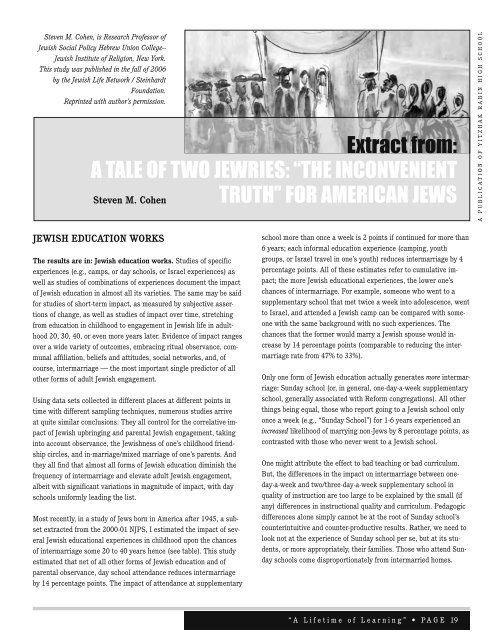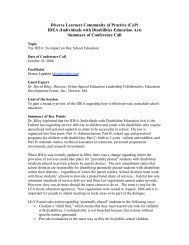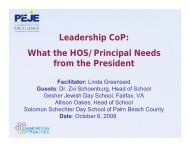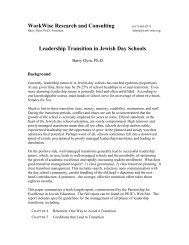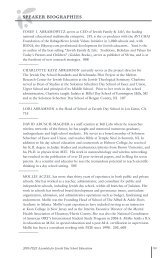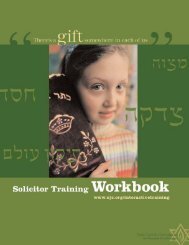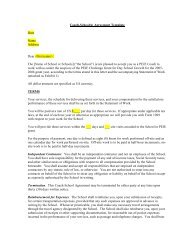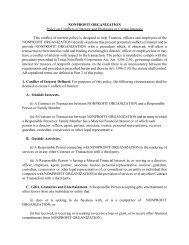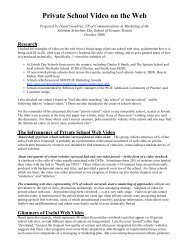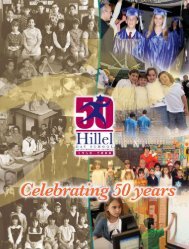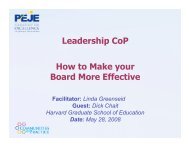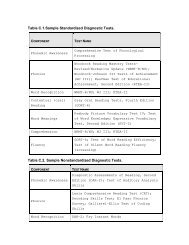âA Lifetim e of Learningâ - Partnership for Excellence in Jewish ...
âA Lifetim e of Learningâ - Partnership for Excellence in Jewish ...
âA Lifetim e of Learningâ - Partnership for Excellence in Jewish ...
You also want an ePaper? Increase the reach of your titles
YUMPU automatically turns print PDFs into web optimized ePapers that Google loves.
Steven M. Cohen, is Research Pr<strong>of</strong>essor <strong>of</strong><strong>Jewish</strong> Social Policy Hebrew Union College–<strong>Jewish</strong> Institute <strong>of</strong> Religion, New York.This study was published <strong>in</strong> the fall <strong>of</strong> 2006by the <strong>Jewish</strong> Life Network / Ste<strong>in</strong>hardtFoundation.Repr<strong>in</strong>ted with author’s permission.Extract from:A TALE OF TWO JEWRIES: “THE INCONVENIENTSteven M. Cohen TRUTH” FOR AMERICAN JEWSA P U B L I C A T I O N O F Y I T Z H A K R A B I N H I G H S C H O O LJEWISH EDUCATION WORKSThe results are <strong>in</strong>: <strong>Jewish</strong> education works. Studies <strong>of</strong> specificexperiences (e.g., camps, or day schools, or Israel experiences) aswell as studies <strong>of</strong> comb<strong>in</strong>ations <strong>of</strong> experiences document the impact<strong>of</strong> <strong>Jewish</strong> education <strong>in</strong> almost all its varieties. The same may be said<strong>for</strong> studies <strong>of</strong> short-term impact, as measured by subjective assertions<strong>of</strong> change, as well as studies <strong>of</strong> impact over time, stretch<strong>in</strong>gfrom education <strong>in</strong> childhood to engagement <strong>in</strong> <strong>Jewish</strong> life <strong>in</strong> adulthood20, 30, 40, or even more years later. Evidence <strong>of</strong> impact rangesover a wide variety <strong>of</strong> outcomes, embrac<strong>in</strong>g ritual observance, communalaffiliation, beliefs and attitudes, social networks, and, <strong>of</strong>course, <strong>in</strong>termarriage — the most important s<strong>in</strong>gle predictor <strong>of</strong> allother <strong>for</strong>ms <strong>of</strong> adult <strong>Jewish</strong> engagement.Us<strong>in</strong>g data sets collected <strong>in</strong> different places at different po<strong>in</strong>ts <strong>in</strong>time with different sampl<strong>in</strong>g techniques, numerous studies arriveat quite similar conclusions. They all control <strong>for</strong> the correlative impact<strong>of</strong> <strong>Jewish</strong> upbr<strong>in</strong>g<strong>in</strong>g and parental <strong>Jewish</strong> engagement, tak<strong>in</strong>g<strong>in</strong>to account observance, the <strong>Jewish</strong>ness <strong>of</strong> one’s childhood friendshipcircles, and <strong>in</strong>-marriage/mixed marriage <strong>of</strong> one’s parents. Andthey all f<strong>in</strong>d that almost all <strong>for</strong>ms <strong>of</strong> <strong>Jewish</strong> education dim<strong>in</strong>ish thefrequency <strong>of</strong> <strong>in</strong>termarriage and elevate adult <strong>Jewish</strong> engagement,albeit with significant variations <strong>in</strong> magnitude <strong>of</strong> impact, with dayschools uni<strong>for</strong>mly lead<strong>in</strong>g the list.Most recently, <strong>in</strong> a study <strong>of</strong> Jews born <strong>in</strong> America after 1945, a subsetextracted from the 2000-01 NJPS, I estimated the impact <strong>of</strong> several<strong>Jewish</strong> educational experiences <strong>in</strong> childhood upon the chances<strong>of</strong> <strong>in</strong>termarriage some 20 to 40 years hence (see table). This studyestimated that net <strong>of</strong> all other <strong>for</strong>ms <strong>of</strong> <strong>Jewish</strong> education and <strong>of</strong>parental observance, day school attendance reduces <strong>in</strong>termarriageby 14 percentage po<strong>in</strong>ts. The impact <strong>of</strong> attendance at supplementaryschool more than once a week is 2 po<strong>in</strong>ts if cont<strong>in</strong>ued <strong>for</strong> more than6 years; each <strong>in</strong><strong>for</strong>mal education experience (camp<strong>in</strong>g, youthgroups, or Israel travel <strong>in</strong> one’s youth) reduces <strong>in</strong>termarriage by 4percentage po<strong>in</strong>ts. All <strong>of</strong> these estimates refer to cumulative impact;the more <strong>Jewish</strong> educational experiences, the lower one’schances <strong>of</strong> <strong>in</strong>termarriage. For example, someone who went to asupplementary school that met twice a week <strong>in</strong>to adolescence, wentto Israel, and attended a <strong>Jewish</strong> camp can be compared with someonewith the same background with no such experiences. Thechances that the <strong>for</strong>mer would marry a <strong>Jewish</strong> spouse would <strong>in</strong>creaseby 14 percentage po<strong>in</strong>ts (comparable to reduc<strong>in</strong>g the <strong>in</strong>termarriagerate from 47% to 33%).Only one <strong>for</strong>m <strong>of</strong> <strong>Jewish</strong> education actually generates more <strong>in</strong>termarriage:Sunday school (or, <strong>in</strong> general, one-day-a-week supplementaryschool, generally associated with Re<strong>for</strong>m congregations). All otherth<strong>in</strong>gs be<strong>in</strong>g equal, those who report go<strong>in</strong>g to a <strong>Jewish</strong> school onlyonce a week (e.g., “Sunday School”) <strong>for</strong> 1-6 years experienced an<strong>in</strong>creased likelihood <strong>of</strong> marry<strong>in</strong>g non-Jews by 8 percentage po<strong>in</strong>ts, ascontrasted with those who never went to a <strong>Jewish</strong> school.One might attribute the effect to bad teach<strong>in</strong>g or bad curriculum.But, the differences <strong>in</strong> the impact on <strong>in</strong>termarriage between oneday-a-weekand two/three-day-a-week supplementary school <strong>in</strong>quality <strong>of</strong> <strong>in</strong>struction are too large to be expla<strong>in</strong>ed by the small (ifany) differences <strong>in</strong> <strong>in</strong>structional quality and curriculum. Pedagogicdifferences alone simply cannot be at the root <strong>of</strong> Sunday school’scounter<strong>in</strong>tuitive and counter-productive results. Rather, we need tolook not at the experience <strong>of</strong> Sunday school per se, but at its students,or more appropriately, their families. Those who attend Sundayschools come disproportionately from <strong>in</strong>termarried homes.“ A L i f e t i m e o f L e a r n i n g ” • P A G E 19


